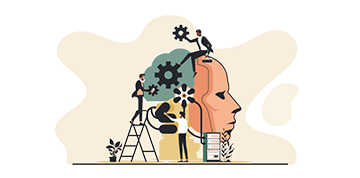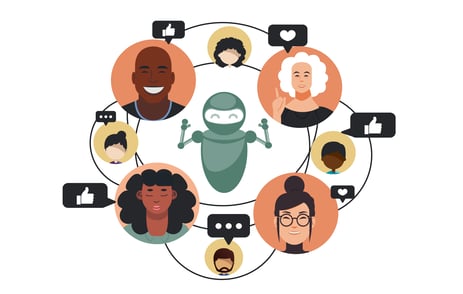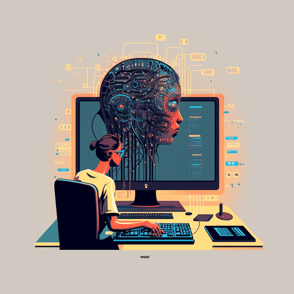As globalization continues to bring the world closer together, associations must find new ways to effectively communicate with their diverse audiences. And while the best content often transcends geographic boundaries, most is written for one language and culture.
While many associations are already working on their global strategy, addressing this concern should be top of mind. For many organizations, that means leveraging translators and outside experts to help tackle a massive backlog of content.
However, generative AI may provide a simpler and more cost-effective solution, helping associations embrace a wider and more diverse audience.
A Brief History of AI Translation
Chances are, you’ve already used an AI translation tool – from Google Translate to the built-in language detection in Facebook. However, this technology has been around a lot longer than that. Originally coined as machine translation (MT), this technology garnered attention as a tool during the Cold War when the Georgetown–IBM experiment (1954) used it to translate Russian messages to English.
However, this was often limited to direct machine translation, where words were translated one-for-one, limiting speed and accuracy while still requiring the oversight of a human translator.
The biggest advancement, however, dates to 2016, when Google launched its Neural Machine Translation System. This system combined the efficiency of MT with neural networks to help expand the capabilities of translation. Instead of translating one phrase at a time, NMT analyzes the entire input and then provides a more accurate and contextually relevant translation.
Today, with advancements in natural language processing and a growing library of data, AI translation is being used for more complex applications like researchers at LMU Munich using it to decode ancient texts or Facebook’s own AI tool that can translate over 100 languages in real-time.
How Can Associations Use AI Translation?
While the technology behind AI translation can be complex (thanks for hanging through that history lesson), the impact it can have on associations is not. From attracting international members and providing a more inclusive culture to amplifying your association's voice and expertise by translating your content, there are plenty of opportunities.
But how can organizations look to implement AI translation today?
- Website localization: English may not be the dominant language for all. AI translation can allow associations to seamlessly convert their content to a range of languages, making it easier for your potential members while also growing the reach and impact of your resources.
- Member support: Associations, particularly those tasked with community-focused support, need to be able to communicate with their members. When language is a barrier, AI translation can help fill the gap.
- Multilingual forums and discussion boards: Community is key – but can all your members participate? AI translation can facilitate seamless communication within online forums, enabling members to participate in discussions with peers from different linguistic backgrounds.
- Real-time event translation: Your annual conference and educational events are an important part of your membership offering. And while closed captioning and translation is available, it’s often something done after the fact. Newer AI translation tools are being developed to provide real-time subtitles or audio translation, ensuring all participants can access and understand the content.
AI in Action: The California Primary Care Association
Part of the CPCA’s mission is connecting Californias with comprehensive healthcare, particularly for those who might otherwise not have access. However, as one of the most culturally diverse states in the country, language barriers can present challenges.
Recently, someone reached out to the CPCA asking to be connected to a local healthcare center – and Courtney Rodseth, Marking and Communications Coordinator had an opportunity to make a difference. “Since I don't speak Spanish, I always have chat GPT open and pasted in his question,” says Rodseth. “He had given me a zip code, and I looked up his nearest health center and answered with the address and phone number. In that case, it [AI] was highly successful in helping connect someone with health care.”
And while this situation doesn’t happen all the time, it’s a representation of a much larger opportunity. “In our 2021 state profile, 31% of the patients marked by our member community health centers have limited English proficiency,” says Rodseth.
Beyond the one-off member support, AI translation can become a tool for other concerns. After a survey done during the pandemic, CPCA found that around 88% of health center staff reported burnout stemming in part from an increased need for patient commutation. “Having a translation resource, like ChatGPT, could be highly beneficial,” says Rodseth.
What Are Some of the Challenges?
Of course, like any new technology, AI translation should be approached with care. Some of the risks associations should consider before going all-in include:
- Loss of accuracy and nuance: AI-based translations may not always be as accurate as human translations, potentially leading to misunderstandings or misinterpretations. For associations representing technical industry knowledge, the nuances, idioms and subtleties in translation can also be an issue.
- Cultural understanding: Just as industry-specific knowledge can impact your translations, so can cultural context. AI translation may struggle to represent the lived and cultural context your staff has, leading to inaccurate or insensitive responses.
- Security and privacy concerns: Confidential information exchanged within the association may be at risk if using third-party AI translation tools. Always be aware of what you’re inputting into a tool before using it.
- Depersonalization: Relying on AI for translation could lead to a loss of personal connection between members, as the emotional aspects of communication can be harder to convey through machine-translated messages.
- Technological limitations: Not all languages may be supported by AI translation tools, which could exclude some members from participating fully in the association's activities.
Reaching a Global Audience
The bottom line is associations can and often do have a global audience and impact. Yet, our methods of interacting with and accommodating these audiences are dependent on outdated tech or practices. While AI translation is not the only answer to this language gap, it can become a valuable tool for your organization and team.
Whether you’re using it for one-off member support, looking for tools to facilitate real-time translation at your upcoming conference or translating some of your most valuable content, there are plenty of opportunities to experiment with. While associations should still be aware of challenges, like inaccuracies or privacy concerns, AI translation offers a glimpse into the impact AI can have on the industry.

Piloting AI
Through Artificial Intelligence (AI), you can make your association more intelligent and your brand more human. That's why hundreds of marketing tasks will soon be intelligently automated to some degree. But where do you begin?

April 18, 2023


